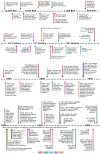The Classification of Substance Use Disorders: Historical, Contextual, and Conceptual Considerations
- PMID: 27548233
- PMCID: PMC5039518
- DOI: 10.3390/bs6030018
The Classification of Substance Use Disorders: Historical, Contextual, and Conceptual Considerations
Abstract
This article provides an overview of the history of substance use and misuse and chronicles the long shared history humans have had with psychoactive substances, including alcohol. The practical and personal functions of substances and the prevailing views of society towards substance users are described for selected historical periods and within certain cultural contexts. This article portrays how the changing historical and cultural milieu influences the prevailing medical, moral, and legal conceptualizations of substance use as reflected both in popular opinion and the consensus of the scientific community and represented by the American Psychiatric Association's (APA) Diagnostic and Statistical Manual of Mental Disorders (DSM). Finally, this article discusses the efforts to classify substance use disorders (SUDs) and associated psychopathology in the APA compendium. Controversies both lingering and resolved in the field are discussed, and implications for the future of SUD diagnoses are identified.
Keywords: DSM; addiction; alcohol; cannabis; cocaine; diagnostic classification; historical; nosology; opioids; substance use disorders.
Conflict of interest statement
The authors declare no conflict of interest.
Figures

References
-
- American Psychiatric Association . Diagnostic and Statistical Manual of Mental Disorders. 3rd ed. American Psychiatric Association; Washington, DC, USA: 1980.
-
- Davenport-Hines R. The Pursuit of Oblivion: A Global History of Narcotics. WW Norton & Company; New York, NY, USA: 2003.
-
- Booth M. Opium : A History. St. Martin’s Griffin; New York, NY, USA: 1999.
-
- Hanson D. Historical Evolution of Alcohol Consumption in Society. Oxford University Press; Oxford, UK: 2013.
-
- Earleywine M. Understanding Marijuana: A New Look at the Scientific Evidence. Oxford University Press; Oxford, UK: 2002.
Publication types
LinkOut - more resources
Full Text Sources
Other Literature Sources

